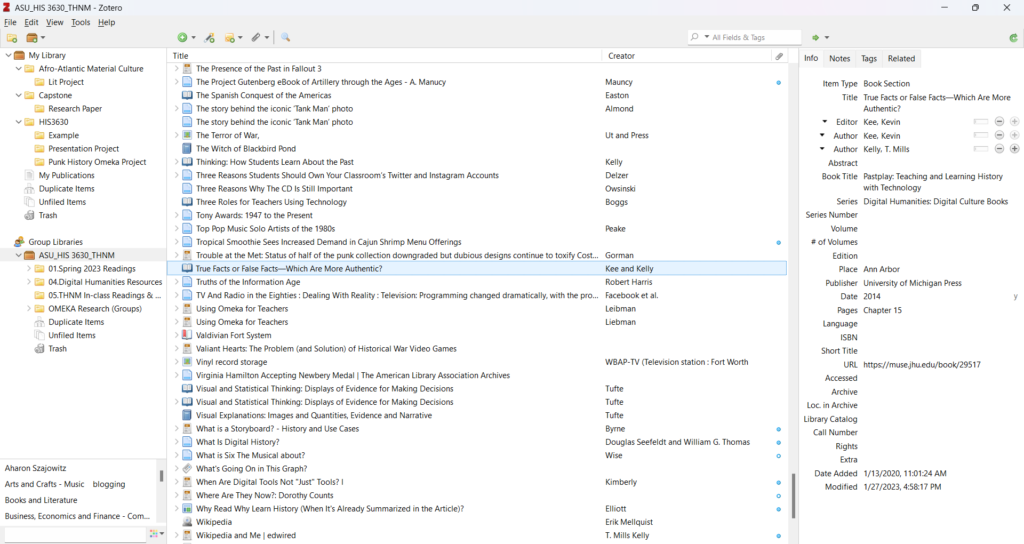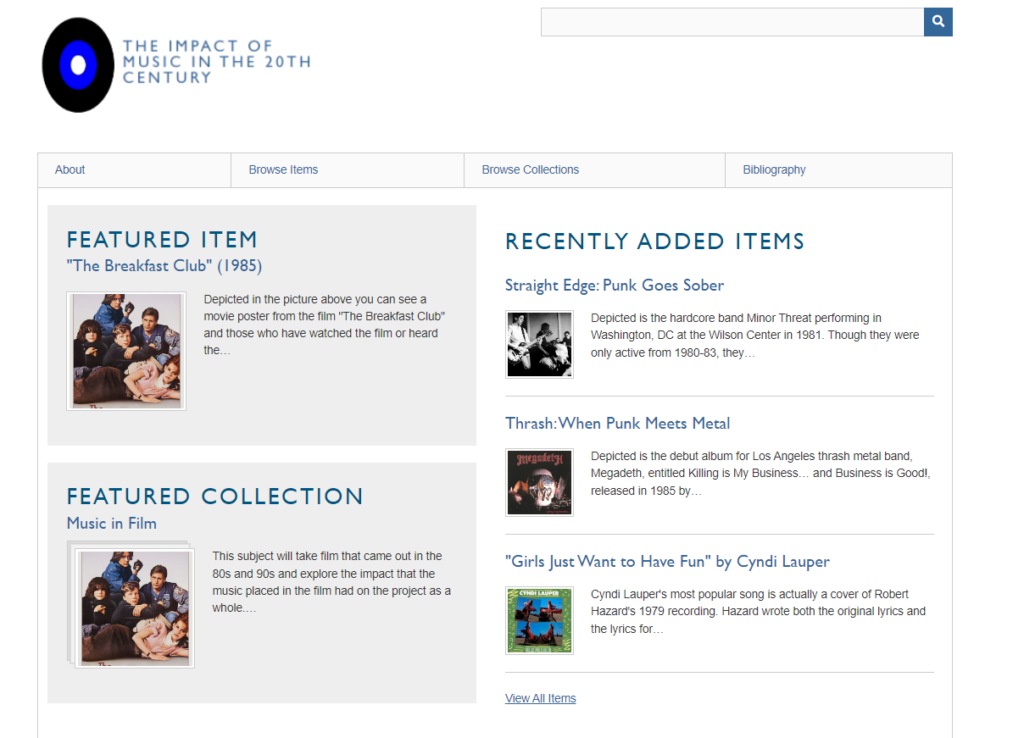As I finish the last semester of my undergrad, I have allowed myself to reflect upon the use of media throughout my studies both during K-12 and into my higher education. As the years have gone by, the work that I have been given has become progressively more digital, in step with the increasing use of technology seen in our daily lives today. And as T. Mills Kelly argues in his article “Presenting: Capturing, Creating, and Writing History,” the job of a historian – a career field I hope to enter one day – is incorporating the use of digital tools far more now than ever before. In this same article, he also states that the way we teach history has not evolved to reflect our increasingly digital world. I have to agree with him. Entering this class was overwhelming for me at first. Though my school had ample technological resources on our hands, the most I’d ever used tech in a historical setting was to create a powerpoint or prezi about the material. Systems like Zotero or Omeka, though quite simple in their design, left me stumbling behind my peers at first, as I’d never worked with anything like them before. The design for Zotero was especially difficult to take in at first, due to the amount of information that was on the screen:

However, through instruction and a hands-on learning experience with both systems, they eventually became instinctual to me, and I have found my experiences with both to be invaluable. Watching my group’s Omeka site come together filled me with a sense of pride in our work, as the end result looked official. I could see myself working on a website for a museum or organization down the line, and that experience was more exciting than any paper ever had been.

This excitement extended even further as we learned how to use other forms of digital media to make teaching – or learning – history more engaging. Learning about interactive maps and data visualizations was far easier for me to digest as well, as they gave a hands-on learning experience to the concepts they discussed, letting visual learners better understand concepts that they might have difficulty processing otherwise. I marveled at how much they could have helped me when I was in school, and how I could use tools such as these in my own presentations, were I to collaborate on a museum presentation, or teach history myself one day.
It left me to wonder why history classrooms are so far behind in their use of digital media. Not everyone who takes a history class wants to be a historian, true. However, given the prominence of digital media in our daily lives – particularly when it comes to our exposure to history and news – it seems vital that we incorporate digital media into the teaching process. As Rob Sterner voices in his article “4 Things You’ll Miss by Banning Cellphones In Your Classroom,” essential discussions about proper use of cell phones (and by extension the sources one might come across via the internet) could be missed without the assimilation of tech.
Take the case of the hoax of Edward Owens, orchestrated by students of T. Mills Kelly for his 2008 class, “Lying About the Past,” which was heartily believed by even teachers and professors until it was exposed as a hoax. If academics far into their career could fall for such a hoax, it should be of the utmost importance that we are taught to critically engage with the media we consume before accepting what is written as fact. I could go on about the family members who, upon listening to a Youtube video essay or a History Channel “historian,” now wholeheartedly believe conspiracy theories such as the nephilim or ancient aliens building the pyramids, however the far-fetched conspiracies are far from the most significant hoaxes we need to watch out for. It is the small things – translations of classical texts, battlefield details, not checking a website’s credentials or sponsors, etc. – that could lead us to believe misinformation, and the last thing any of us should want is to misrepresent our history, particularly to the younger generations, but also to ourselves. And it is through teaching ourselves and our youth how to properly digest digital information that we will be able to prevent this from happening.

The internet is a vast expanse of resources and information, and an incredible tool for those who wish to teach, or to learn. Why don’t we use it?
Sources:
Rob Sterner, “4 Things You’ll Miss by Banning Cellphones in Your Classroom,” Teachingquality.org (February 24, 2015). https://www.teachingquality.org/4-things-youll-miss-by-banning-cellphones-in-your-classroom
T. Mills Kelly, “Presenting: Capturing, Creating, and Writing the Past” in Teaching History in the Digital Age, Ann Arbor: University of Michigan Press, 2013. https://muse.jhu.edu/pub/166/oa_monograph/chapter/817459
T. Mills Kelly, “True Facts or False Facts —Which Are More Authentic?” In Pastplay: Teaching and Learning History with Technology, edited by Kevin Kee, Chapter 15. Ann Arbor: University of Michigan Press, 2014.
First two images are my own screenshots.
Last image credited to: https://www.tfeconnect.com/4-benefits-of-having-internet-in-the-classroom/